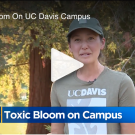Cyanobacteria FAQ
During the Summer of 2021, we tested for and found that cyanobacteria exists in the Arboretum Waterway. Commonly found in bodies of water throughout our state, nation and world, cyanobacteria usually occur in calm, nutrient-rich bodies of water.
Please note that cyanobacterial toxins can be harmful and even life threatening to canines. Do not let your dogs enter or drink the water.
Below are some FAQs related to the recent discovery.
- Why is the Arboretum Waterway so green in the summer?
- The green color is the result of algae and cyanobacteria that grow during the warm months, when there is also more sunlight. There are over 200 species of algae and cyanobacteria in the Arboretum Waterway (Waterway).
- Is this natural?
- Yes. Almost all water bodies have naturally occurring algae and cyanobacteria. When the temperature and day length increase, the likelihood of a bloom increases. Blooms aren’t predicable and won’t always happen in summer, but they are more likely this time of year. Learn more about when and where blooms are reported locally and throughout the state.
- Is the bloom a result of the recent Arboretum Waterway Maintenance and Enhancement Project or other campus activities?
- No. The Arboretum Waterway Maintenance and Enhancement Project created flow within the east end of the waterway. This flow prevents the buildup of thick mats of surface algae that previously were found in the stagnant waters of the east end. Circulation can’t prevent buildup of algae or cyanobacteria in the water column, as the water is still warm with available nutrients. Algae and cyanobacteria are natural parts of warm water ecosystems. All campus water entering the waterway meets State and Federal water quality standards.
- Is the cyanobacteria harmful to pets and wildlife?
- Cyanobacteria can produce cyanotoxins. The risks of cyanotoxins to natural resources remain relatively unknown. Health problems may occur in wild animals if they are chronically exposed to fresh water with cyanotoxins. We are continuously monitoring for impacts to the wildlife within the waterway. Cyanobacteria can be life-threatening to dogs and they should not enter or drink from the Arboretum Waterway.
- What are signs of possible cyanobacterial toxin poisoning in dogs?
-
Animals can experience symptoms within minutes to days following exposure to the cyanobacterial toxins (cyanotoxins). Symptoms they might experience include vomiting, diarrhea, weakness, difficulty breathing, seizures or death. If your pet experiences these symptoms after exposure, contact your veterinarian immediately. A veterinarian fact sheet is available. For additional assistance, contact the 24-hour ASPCA Animal Poison Control Center hotline at (888) 426-4435. A $65 consultation fee may be applied.
1-page Fact Sheet for Pet Owners (June 2018)
The information found in this answer is excerpted from My Water Quality Monitoring Council website. - Can you tell if cyanotoxins are present by looking at the water?
- Although there are materials available to help the public when making a visual determination, they are not fail-safe. We do not recommend that you decide whether or not harmful toxins exist in the water by sight alone as harmful toxins may be present without a corresponding display of a certain color or texture.
- Is the cyanobacteria harmful to humans?
- Direct contact with a cyanobacteria bloom from water-based activities has been reported to cause hay fever-like symptoms (itchy eyes, sore throat, congestion) and skin reactions (rashes, blistering) at high concentrations. Ingesting contaminated water can cause gastrointestinal distress (diarrhea, abdominal pains, nausea, vomiting). The effects of chronic low-level exposure, for example from eating contaminated fish, have not been studied.
- What should we do?
- Do not enter the Waterway or allow pets (especially dogs) to enter the water!
- How long will the bloom last?
- There is no way of predicting how long the bloom will last. Once the weather has cooled down and the days are shorter, the bloom should subside.
- What can be done to prevent blooms like this?
- Projects like the Arboretum Waterway Maintenance and Enhancement Project, which increases movement of the water, can help reduce the likelihood of blooms. However, in environments with warm water and adequate nutrients, blooms will always be a possibility. As they are a natural phenomenon, the best way to avoid the impact of blooms is to avoid contact with the water.
- Are blooms like this happening in other places?
- Yes. In the summer of 2019, blooms were reported in the Sacramento River, American River, San Luis Reservoir, Folsom Lake, Clear Lake, as well as the Sacramento San Joaquin Delta.
- Where can I find more information?
- Below is a list of resources available on the California Harmful
Algal Bloom portal.
Freshwater and Estuarine Harmful Algal Blooms
Livestock and other Large Animals
In the News

Keep Dogs Clear of the Waterway
Article from UC Davis News | September 8, 2021

Toxic Bloom on Campus
CBS 13 Sacramento | September 23, 2021
